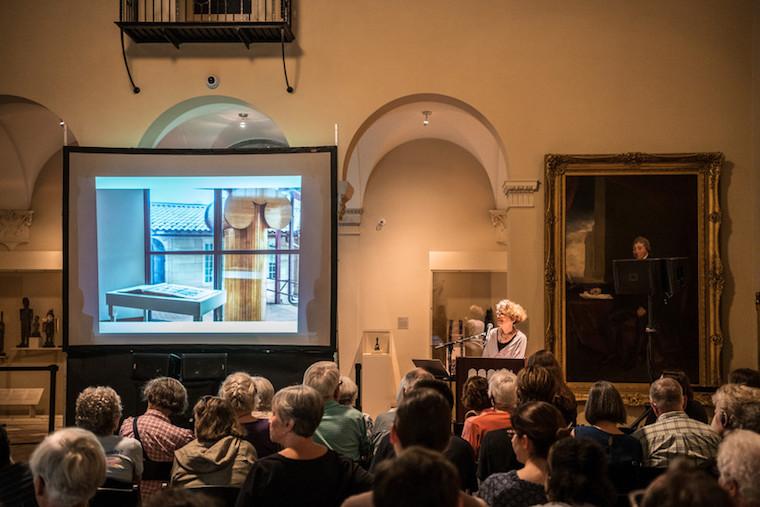Barbara Bloom Gives First Thursday Talk
September 19, 2018
Erin Ulrich ’18

Known for her work with Pictures Generation artists, Barbara Bloom opened this year’s First Thursday series by addressing Oberlin College students and the wider community.
Bloom’s installation is part of Front International: Cleveland Triennial for Contemporary Art, which was orchestrated by FRONT Executive Director Fred Bidwell ’74. Bidwell has described FRONT’s mission as “about redefining the city [of Cleveland] to the world and to itself.” The triennial has attempted to redefine Cleveland to the “outside world” by inviting artists from around the globe to showcase their work in Cleveland, which still bears the effects of past economic recessions.
Roughly 35 miles southwest of FRONT's geographic nucleus, Bloom’s installation is housed in the Ellen Johnson Gallery at the Allen Memorial Art Museum (AMAM). Bloom spoke to a full house in the King Sculpture Court earlier this month about her installation, THE RENDERING (H x W x D =), which will run through December 16, 2018.
Ellen Johnson ’33 Assistant Curator of Modern and Contemporary Art Andrea Gyorody was instrumental in making the installation happen and assisting Bloom with the process of sorting through the AMAM’s collection of artworks.
Gyorody says, “It was a shared task in the sense that, when Barbara came to visit, I took her to storage downstairs and she saw everything in the museum. It was a little bit like she was going shopping, with other members of our staff and me as her guides.”
When you first walk into the Ellen Johnson Gallery, the enormity of the physical space itself is striking. The immensity of the space forces its viewer to take in Bloom’s entire installation at once—yet, the complexity and sheer scope of the gallery denies the viewer the luxury of grasping THE RENDERING in its entirety upon first glance. Even if you didn’t pick up on the allusion in the installation’s title (“height times width times depth”), THE RENDERING screams architecture.
“If you come in here and think, ‘What is this crazy installation?’ It should hopefully hit you in a few minutes that the installation is about architecture, perhaps without even reading the text at the front that makes that explicit,” Gyorody says.
Throughout the installation, there are other not-so-subtle clues that THE RENDERING is about architecture. The painting on the title wall, which features William Hogarth’s Portrait of Theodore Jacobsen, is concealed, except for the subject’s hands and the drawing he holds in them.
Other pieces from the AMAM’s collection featured in the installation are similarly concealed, save the snippets of architecture within the works. The most conspicuous components of the installation are the three-dimensional “renderings” interspersed throughout the gallery that appear to extrude from the prints on the walls they correspond to. For instance, a life-sized bridge in Kitagawa Utamaro’s The Palace of the Moon woodblock print stands in front of its bridge counterpart in the print, almost as if reaching out to it.
Gyorody says, "When Bloom came to Oberlin for the first time, she hadn't yet chosen any works nor a particular theme, wanting to allow the collection to guide her thinking. What wound up giving form to the project, more than anything else, was Bloom's encounter with the gallery space itself, designed by postmodern architect Robert Venturi in 1975. The space has so many quirks and oddities—these are really what captured Bloom's attention and changed the course of her engagement with the collection."
When remarking on her thought process for THE RENDERING, Bloom says, “It’s almost like the dramaturgy of a theater piece, or the choreography of a dance work. I’m always thinking about the way things in a space relate to and ricochet off of each other. So, I’m hoping that the experience of coming into a space is visually delightful. That it’s not a chore to be in there.”
Bloom's FRONT-commissioned installation is presented with support from the Eric & Jane Nord Family Fund and the Nord Family Foundation. The AMAM First Thursday series features three speakers this fall—New York based-artist Barbara Bloom, Pictures Generation artist Philip Smith, and Deputy Director of the California African American Museum Naima J. Keith. The AMAM’s First Thursday series offers free programs open to the public—including talks by artists whose works are on display in the museum. Galleries remain open until 7:30 p.m. the day of the talk and a Q&A with the speaker is followed by light refreshments and conversation in the East Gallery, where students and museum-goers can interact directly with speakers in the series.
Tags:
You may also like…
Longtime Allen Memorial Art Museum Director Andria Derstine Announces Departure
October 14, 2024
After more than a decade of exemplary leadership, Andria Derstine is leaving her post as the John G. W. Cowles Director of the Allen Memorial Art Museum (AMAM) at Oberlin College
Omar Tells His Story
October 11, 2024
This December, Oberlin will present a concert version of Rhiannon Giddens’ award-winning opera, both at Finney Chapel in Oberlin and the Maltz Performing Arts Center in Cleveland. Surrounding it are all kinds of cross-disciplinary events for campus and community.
3 Things with Matthew Rarey
January 31, 2024
Matthew Rarey, the chair of Oberlin’s art history department and an associate professor of African and Black Atlantic art history, won the College Art Association’s prestigious Charles Rufus Morey Book Award in 2024.


